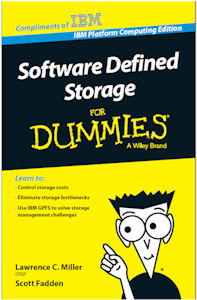Software Defined Storage for Dummies
June 12, 2014
 Dear Desktop Engineering Reader:
Dear Desktop Engineering Reader:
I once worked in a building that was the headquarters for the American Guernsey Cattle Club. At the AGCC, rows of little of old ladies at Army surplus desks recorded cow lineages. They’d drop completed folders in gray metal carts wheeled around by some old guys, who took them off for archiving. Dull green filing cabinets lined every inch of wall space, and they never had enough file space. How they found files is anyone’s guess. With the world generating something like 15 petabytes of data daily, IT administrators can relate.
 Keeping up with and managing data storage growth is among the top challenges facing IT. All sorts of data is stored, backed up and retrieved: transactions, stuff from digitally aware devices and structured and unstructured data. Many technologies exist to deal with data glut: Network-attached storage (NAS) devices, direct-attached storage (DAS), storage area networks (SAN), a bunch of hard disks and so forth. Still, data growth exceeds IT storage budget growth. These sorts of things make data storage and management a constant concern.
Keeping up with and managing data storage growth is among the top challenges facing IT. All sorts of data is stored, backed up and retrieved: transactions, stuff from digitally aware devices and structured and unstructured data. Many technologies exist to deal with data glut: Network-attached storage (NAS) devices, direct-attached storage (DAS), storage area networks (SAN), a bunch of hard disks and so forth. Still, data growth exceeds IT storage budget growth. These sorts of things make data storage and management a constant concern.
“Software Defined Storage for Dummies” by Lawrence C. Miller and Scott Fadden proposes software-defined storage as the enterprise-class storage solution that can provide flexibility, automated management, cost efficiency and virtually limitless scalability for the job. Specifically, this book explores and explains the IBM General Parallel File System (GPFS). But you do not need to be in the market for a data-glut solution to gain big time knowledge from this well-done e-book. There’s a lot going on here.
Written for IT managers, storage administrators, decision-makers and the techno-savvy out for a good read, this 74-page e-book has six chapters. The first two discuss the challenges data storage presents IT and the software-defined storage concept, respectively. They are worth the download alone. The next two chapters focus on the features and benefits of IBM GPFS with great granularity. They will fascinate the techno-curious. The serious reader, however, gets the fascination and the hard-core details on what IBM GPFS could bring to their enterprise that will enable them to make informed decisions.
The fifth chapter provides real-world case studies from industries such as engineering analysis and energy. The sixth explores the potential ways IBM GPFS can help you manage your storage challenges and enhance operations like enterprise analytics and R&D. These last two chapters will be particularly useful to anyone pitching their less-technical bosses to further investigate software-defined storage. Couple them with the first two chapters, and you have a first-class cause and solution presentation.
That’s all fine and dandy, but what is software-defined storage? The book devotes entire chapters to answering that, but for now think of it as a relatively new storage technology that uses standard hardware to its fullest. It performs the important storage and management functions in intelligent software, and provides automated, policy-driven, application-aware storage services. Standard hardware means it leverages familiar disk storage technologies such as SAN and NAS, network devices like switches and network interfaces, and servers for storage processing, management and administration. A key attribute is that software-defined storage could provide you with massively scalable file system storage capabilities.
As for IBM GPFS software, it runs on IBM and third-party platforms and can be deployed on a variety of commodity hardware systems as well as part of an integrated appliance. That is, it doesn’t require expensive proprietary hardware. By using standard hardware, it can lower your acquisition costs and TCO (total cost of ownership) for an enterprise-class storage solution compared to traditional methods.
But let’s get to the nub of what you probably really want to know: Scalability and capacity. IBM GPFS supports 1 to 16,384 nodes in a cluster and approximately 9 quintillion files per file system. The maximum file system size is one million yottabytes (one yottabyte is equal to one trillion terabytes).
“Software Defined Storage for Dummies” was an excellent surprise. It’s thoroughly enjoyable reading, engagingly written and packed with charts. You should learn something pretty much on every page. Can’t go wrong with that. Anyone with an interest in storage data management or a career staked on doing it right and cost-effectively will surely get a lot out of this book. Hit today’s Check It Out link to get your complimentary copy of “Software Defined Storage for Dummies.”
Thanks, Pal. – Lockwood
Anthony J. Lockwood
Editor at Large, Desktop Engineering
Subscribe to our FREE magazine, FREE email newsletters or both!
About the Author
Anthony J. Lockwood is Digital Engineering’s founding editor. He is now retired. Contact him via [email protected].
Follow DERelated Topics






